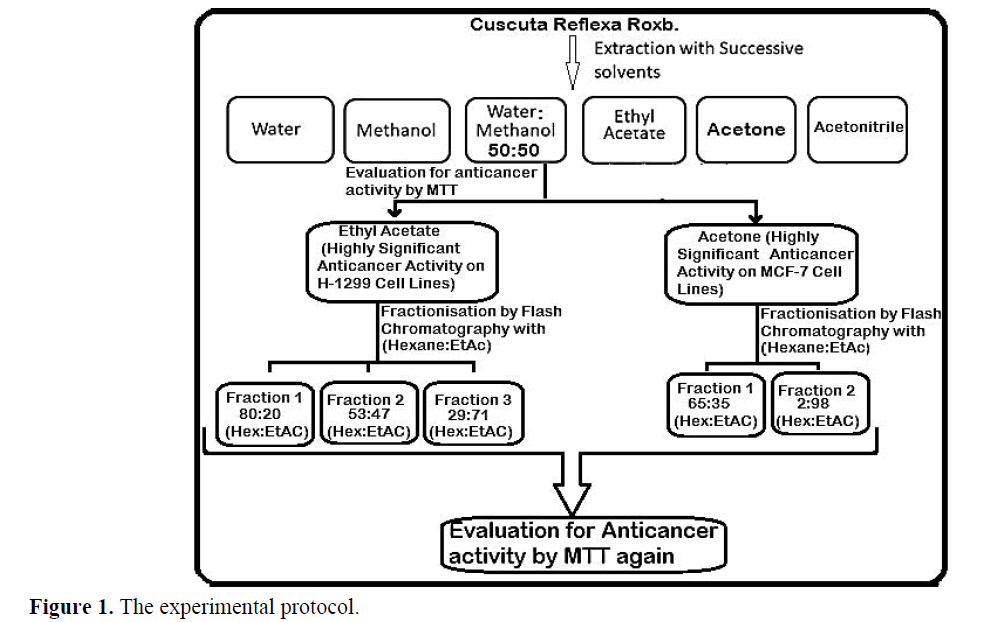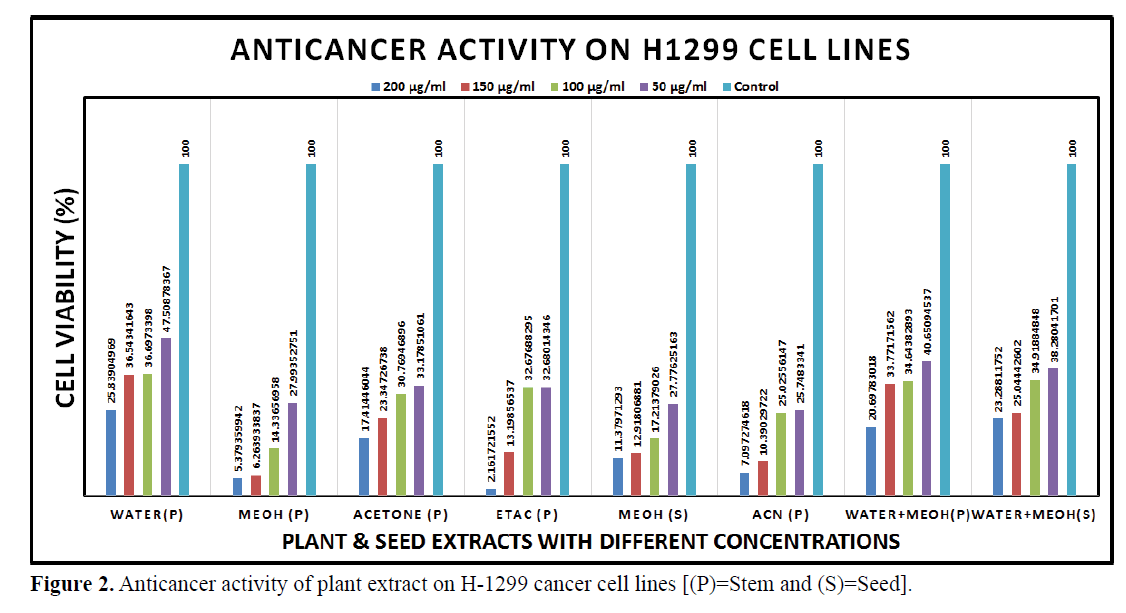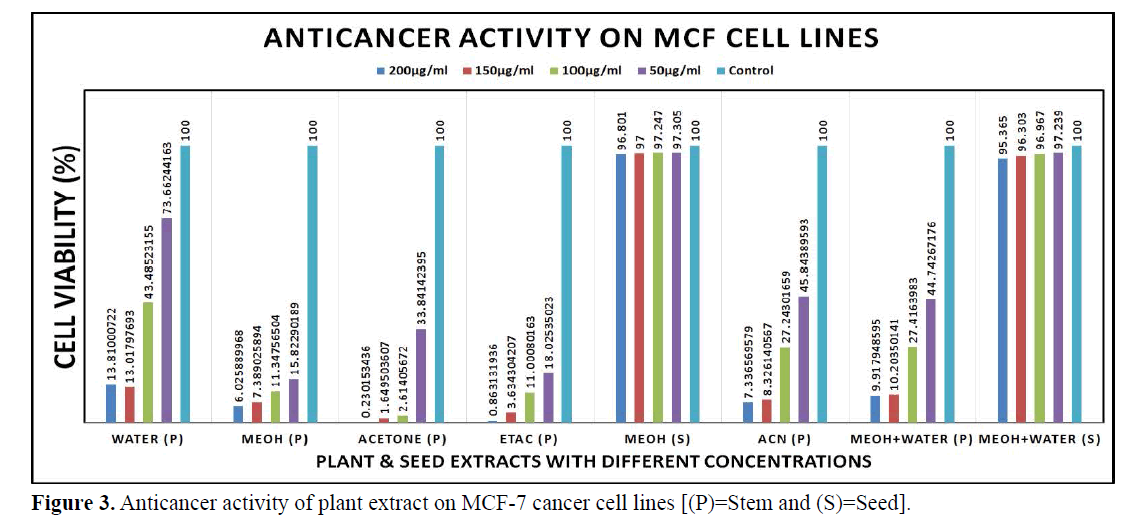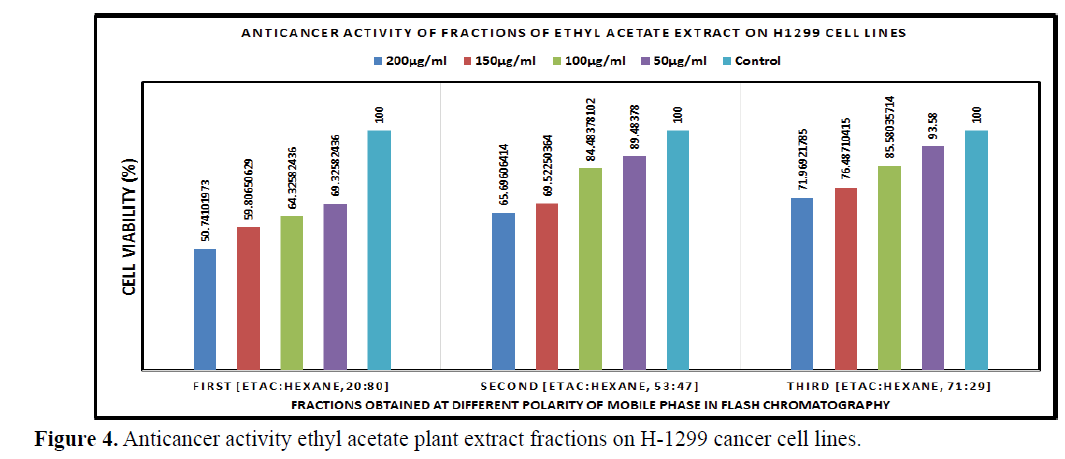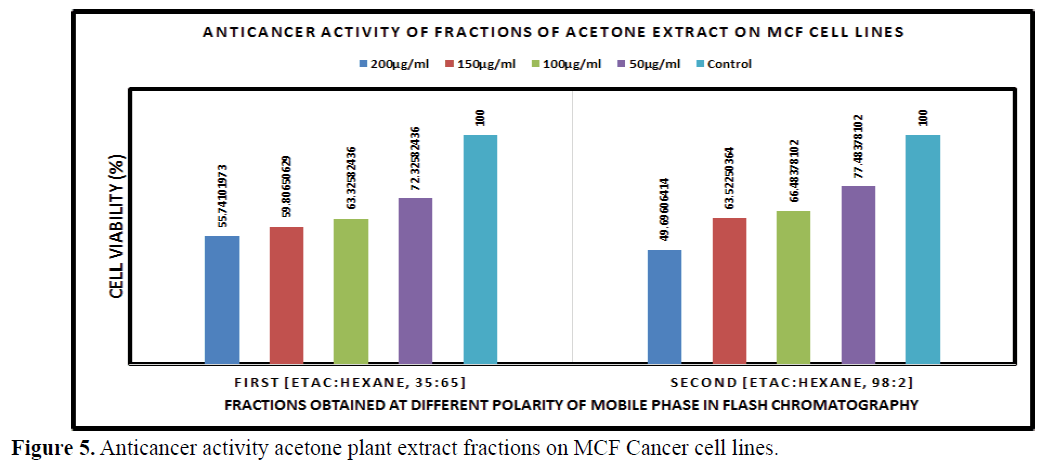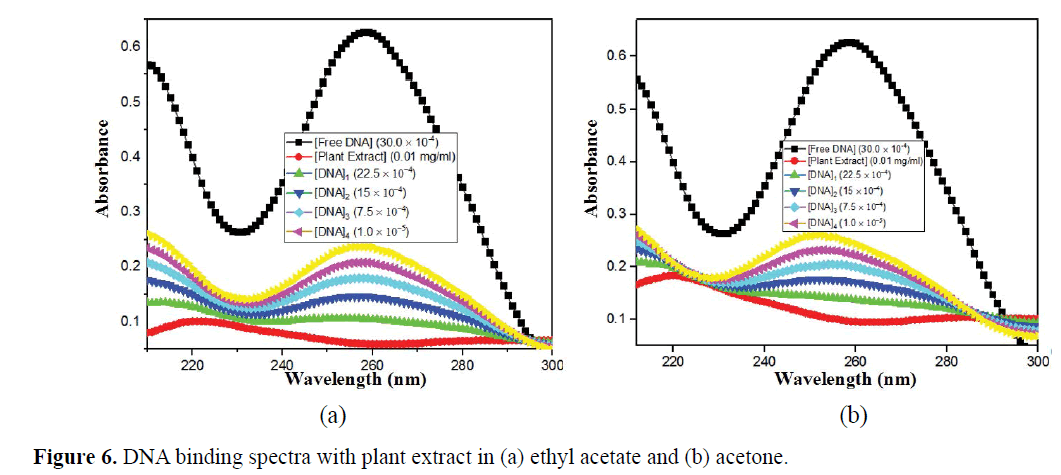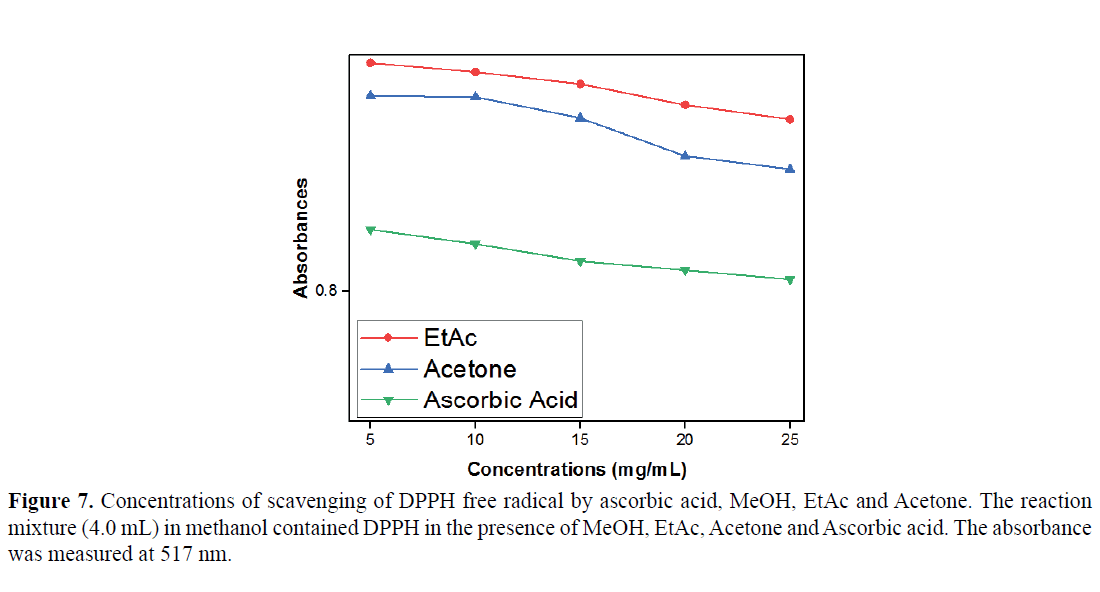Keywords
Cuscuta reflexa Roxb., H-1299, MCF-7 cell lines, Cytotoxicity,
Anticancer treatment
Introduction
Today, there are many diseases around us, but cancer is
the riskiest ailment [1-12]. The rates of death due to cancer
are similar in males as well as in female [13]. All over the
world, the different treatments for cancer are being used.
For chemotherapy, some drugs have been synthesized
chemically and used in cancer treatment, which has many
side effects [14-17]. But among all the treatments, Unani
medicines have their own unique position in cancer therapy
[18]. In Asia, there are different types of plants having
bioactive compounds, which have been used as Unani
medicines. Aftimoon with botanical name Cuscuta reflexa Roxb. is one of them [19]. This plant is parasitic in nature
with a slender yellow stem as it draws nutrition from the
host after fixing on other plant's body [20]. It is widely found
in temperate and tropical regions and commonly found
throughout India. In Ayurvedic medicine, aftimoon has been used in various diseases such as diseases of eye, heart,
digestive system, diaphoretic, protracted fever, purgative
etc.[21-27]. The chemical examinations have been carried
out along with pharmacological studies on this plant. The
seeds and stems of aftimoon are of high medicinal values for
carminative, anodyne, purgative, hair growth etc.[28,29].
The seeds are given as a depuration and carmination in
stomach pains and aches. The seed poultice can also be used
locally for removing pains. The stems in decoction are useful
in flatulence, constipation, liver complaints and bilious
affection [30]. Equiguard is a Chinses medicine for curing
kidney problems and aftimoon is one of the constituents of
this. Research of New York Medical College has indicated
that the use of Equiguard may be beneficial to treat cancer
[31]. It may be due to apoptosis of cancer cells; describing
the therapeutically aspects of this plant [32]. The authors
reported the use of the plant in the treatment of melanous, melancholia, numpness, epilepsy, facial palsy, paralysis,
worm infestation, arthritis, weakness of liver, jaundice,
stomach and spleen. Furthermore, the authors also described
the plant applications in solving the problems of the
resolvent, cathartic to black bile and phlegm, anti-helmintic
demulcent, and carminative. Besides, In vitro study on the
plants indicated their antioxidant activity via free radicals
scavenging activity due to phenolic compounds in their
extracts.[33] Chatterjee et al. [25] reported the antitumor
activity of Cuscuta reflexa roxb. With swiss albino mice
using hot water extract of Cuscuta reflexa roxb. The extract
was applied on the skin papillomas and carcinomas induced
by 7,12-dimethylbenz[a]anthracene. In this way, aftimoon
is having quite good anti-cancer activities and, hence, it is
considered as the most important plant in the Unani system
of medicine but unfortunately, no systematic study is carried
out. In view of this, the systematic study of this plant is
carried out to determine the anticancer potential. The plant
material is extracted with different solvents, and fractionated
with flash chromatography. The different fractions were
studied through DNA binding, antioxidant and anticancer
activities. Finally, the chemical compositions of the most
active extracts and fractions were determined (Figure 1).
Figure 1. The experimental protocol.
Methods
The following work was carried out under this section.
Collection and Authenticity of Plant
The plant materials (of 3 months old; plant age) were
collected from Deoband (Saharanpur) of U.P., India and the
genus and species of the medicinal plants are authenticated
through Indian Agriculture Research Institute, Delhi, India,
where specimen for plant was deposited.
Preparation of Plant Extracts
The extractions of the plant stems and seed were carried
out in the different solvents using Soxhlet apparatus.
The collected plant materials were dried in the shed and
powdered using the grinder. 25 g Powder of both dried
stems and seeds were taken in a Soxhlet apparatus with 500
mL of extracting solvents. The plant stems and seeds were
extracted in various solvents i.e. plant stem in acetone (I),
plant stem in acetonitrile (II), plant stem in ethyl acetate
(III), plant stem in methanol (MeOH; IV), plant stem in
water-methanol (H2O-MeOH; 50:50; V), plant stem in
water (H2O; VI), plant seed in methanol (MeOH; VII) and
plant seed in water (H2O; VIII), separately and respectively.
During the extraction procedure, the colorless extracting
solvents became colored indicating the dissolution of the
plant material constituents in the solvents. The extraction
was carried out till the extracting solvents became colorless
in the rotary evaporator apparatus arm. After this procedure,
the extracts were filtered using Whatman filter paper No.
24. The filtrates were reduced to 50 mL using a vacuum
rotary evaporator apparatus. These reduced filtrates were
kept in a freeze for further studies.
Anticancer Activities
The anticancer activities of the plant extracts were assessed
by performing cell line studies by colorimetric assays
(MTT and MTS both). Tetrazolium dyes are the most
versatile dyes used for cytotoxicity (loss of viable cells)
or cytostatic activity (proliferative to resting status shift)
studies. XTT [(2,3-bis-(2-Methoxy-4-nitro-5-sulfophenyl)-
2H-tetrazolium-5-carboxanilide); C22H17N7O13S2], MTS
and WSTS (water-soluble tetrazolium salts) are the most
studied dyes for cell line studies. MTT is widely used for
assessment of cytotoxicity, cell viability and proliferation
studies in cell biology. MTT gives a yellowish aqueous
solution, which on reduction by mitochondrial succinate
dehydrogenase, present in metabolically active cells, yields
a water-insoluble violet-blue formazan crystal. The lipidsoluble
formazan product may be extracted with organic
solvents (e.g. DMSO, iso-propanol; C2H6OS, C3H8O) and
estimated by ELISA reader in the range of 500-600 nm.
Eight plant extracts were tested for their cytotoxic activities
against human breast cancer cell line (MCF-7) and lung
cancer cell line (H-1299) at different concentrations using
MTT assay according to the method of Mosmann. The
anticancer activities of the plants' extracts were performed
with different concentrations such as 200, 150, 100 and
50 μg/mL on two different cancer cell lines i.e. H-1299
(lung cancer) and MCF-7 (breast cancer) cell lines. In
vitro anticancer profiles of the plant extracts were screened
against human lung cancer (H-1299) and breast cancer cell
lines (MCF-7) by MTT assay. DMEM (low glucose), 10%
fetal bovine serum and antibiotics/antimycotics formed the
main constituents of the culture medium. The cancer cell
lines were seeded in 96-well plate at a density of 2 × 103
cells/well. These were incubated at 37°C under a humidified
atmosphere containing 5% CO2 for 24 h before assay. The
cells were further incubated in media containing various
concentrations of the extracts. After 24 h, the medium
was removed and washed with PBS. About 20 μL of MTT
solution was added to each well followed by 4 h incubation
at 37°C. Subsequently, the medium was removed followed
by addition of 200 μl DMSO. After slowly shaking (twice)
for 5 s, the absorbance of each well was determined at 570
nm. The cell viability (%) was calculated as the ratio of the
number of surviving cells with test compounds and blank.
Similarly, the anticancer studies on lung and breast cancer
cell lines were performed using the MTS; developed by
Promega. The compounds and the extracts were dissolved in
DMSO at a concentration of 0.5 mg mL-1. The investigation
was carried out by dilution of stock solution in the ratio
of 1:10, 1:100, 1:1000 and 1:10000. The samples of cells,
grown in non-modified medium, served as controls. After
24 h of incubation, MTS colorimetric assay of cell survival
was performed. The wells were treated with MTS solution
and incubated for 2 h at 37° C under 5% carbon dioxide and
95% air atmosphere. The absorbance of each well at 490 nm was read by an automatic microplate reader (‘‘Tecan’’,
Austria). Relative cell viability, expressed as a percentage
of the untreated control (100% viability), was calculated for
each concentration.
Fractionation of Plant Extracts
After checking the anticancer potential of Cuscuta reflexa Roxb. extracts, fractionation of these extracts was carried
out by flash chromatography; to find out the number of
components and their activities. The flash chromatography
with a binary and quaternary solvent delivery system, UVVis/
Dual variable wavelength detector, Cheeta purification
software (Bonna-Agela Technology, China.) was used.
Hexane-Ethyl Acetate-MeOH of varied ratio was used
as the mobile phase with flow rate of 30 mL/minute. The
column used was of silica (20 g, 40-60 μm). 500 mg Crude
extract was mixed with silica to make it in the form of slurry
and loaded into silica column and eluted with the abovementioned
solvent in increasing polarity ratio. The fractions
(30 mL) were obtained with an increase in polarity of the
mobile phase i.e. with the increasing volume of ethyl acetate.
The purity of each fraction was checked by TLC using
methanol-chloroform (1:9, v/v) as a mobile phase. The spots
were detected and identified in a long UV cabinet. Besides,
TLC plates were also identified using iodine chamber. The
fractions having the same Rf were pooled together to obtain
the individual fraction. After fractionation, the anticancer
activity of each fraction was also checked.
DNA Binding Studies
Literature indicates that about 90% anticancer agents act by
attacking DNA of the cells [34-39]. Therefore, the attempts
were made to study the bindings/interactions of the plant
extracts with DNA. The study of interactions of the plant
extracts with Ct-DNA was carried out at pH 7.4 in a solution
of double distilled water containing tris-(hydroxymethyl)-
amino methane (Tris, 10−2 M). Initially, the concentration
of freshly prepared Ct-DNA solution was determined by
UV–Vis absorption spectrophotometry at a wavelength of
260 nm (ε = 6600 M−1 cm−1) [40]. The purity of DNA as
a stock solution of Ct-DNA was determined by taking the
ratio of A260/A280 ≥ 1.80, which indicates the sufficiently
protein-free nature of DNA [41]. The concentration of the
stock solution of DNA was experimentally determined
by utilizing ɛ=6600 M−1 cm−1 at 260 nm. The additional
solutions of DNA were made from a stock solution (30 ×
10-4 M) with a fixed concentrated solution of plant extracts
(0.01 mg/mL).
To carry binding experiments, the absorption spectra of
freshly prepared plant extracts at a fixed concentration
of (0.01 mg/mL) were taken with the increase in the
concentration of DNA (1.0 × 10−5 to 30.0 × 10−4 M). First of
all, λmax and absorbance of pure DNA and compounds were
recorded separately in tris-buffer solutions. Then λmax and absorbance of mixture i.e. 2.0 mL of each solution of DNA
and compounds were recorded. The absorption spectra were
recorded after each addition of the different concentrations
of DNA solution (2.0 mL). To produce constant results,
the titration experiments were repeated five times. The
intrinsic binding constants (Kb) were determined by Benssi-
Hilderbrand equation modified by Wolfe A, et al. [42]. The
equation is as below:

where, absorption coefficients, εa, εf, and εb correspond to
Aobs/[compound], extinction coefficient for the compound
and the extinction coefficient for the compound in the fully
bound form, respectively. The binding constants for the
different compounds (Kb) were determined by the slopes
and the intercepts of the plots of [DNA] / (εa - εf ) vs. [DNA].
Antioxidant Activity
The stable 1,1-diphenyl-2-picrylhydrazyl (DPPH) free
radical was used to assess the antioxidant activities of the
plant extracts fractions using the standard modified method
[43]. A solution of ascorbic acid (1.0 g/L) was prepared in
methanol. The solution of DPPH (0.04%) was prepared in
methanol, which was used as standard. The stock solutions of
the plant extracts (400 mg) of the three extracts in methanol,
ethyl acetate and acetone were taken and dissolved in 1.0 L
methanol, separately and respectively. These were diluted
to 300 200, 100 mg/L. To carry out the experiment, the
absorbance and λmax of pure DPPH were recorded. Later, 3.0
mL of DPPH was mixed with 2.0 mL of ascorbic acid and
the absorbance and λmax were recorded immediately. The
same experiments were repeated with DPPH and the three
plant extracts at different concentrations i.e. 400, 300 200,
and 100 mg/L were used. All these solution mixtures were
kept in dark for 30 min. and optical density was measured
at 517 nm using UV/Vis spectrometer. The blank used
was methanol (1.0 mL) having DPPH (0.04%, 1.0 mL).
The blank solutions were used to correct values for radical
decay. All the measurements were carried out for five times
(n = 5). The concentration of the sample required to inhibit
50% of the DPPH free radical is called as IC50 value of the
sample. This was calculated using the log dose inhibition
curve. Low absorbance of the mixture of the sample
solution and DPPH indicated high free radical activity of
the reaction mixture [44].
Results and Discussion
Preparation of Plant Extracts
During the extraction procedure, it was observed that the
colors of the extracting solvents were different after the
complete extraction. This observation clearly indicated
that the various solvents have different constituents of the
plant materials. It was due to the different polarities of the
extracting solvents. Furthermore, the color of the extracting solvents became dark on reducing the volumes of the
extracting solvents by rotary evaporator apparatus under
vacuum.
Anticancer Activities
The anticancer activities were measured with MTT
assay and the results are presented in Figures 2 and 3 for
H-1299 cancer cell lines and MCF-7 cancer cell lines,
respectively. The anticancer activity of all the plant extracts
against cancer cell lines increased with increase in the
concentration (Figures 2 and 3). The anticancer activities of
the plant extract were in the order of 200>150>100>50 μg/
mL concentrations. The percentage of anticancer activities
for lung cancer cell lines in terms of viability were in the
range of 2.16 to 47.50% for all the extracts. The order of
anticancer activities of the plant extracts was ETAC (P)
>MeOH (P) > ACN (P) >MeOH (S) > Acetone (P) > Water-
MeOH (P) > Water-MeOH (S) > Water (P). Among them,
ethyl acetate extract was found more active with anticancer
activities in the range of 2.16 to 32.68% (viability) for all
the concentrations used. The IC50 and Hill’s constant values
for lung cancer cell lines were 74.48 to 902 μg/mL and
0.95 to 23.95 (Table 1). It is clear from this table that ethyl
acetate extract was the best one with minimum value of IC50 and higher value of Hill’s coefficient. These values were in
good agreement of DNA binding studies results.
| Plant Extracts |
IC50 (µg/mL) |
Hill’s Coefficient |
| Stem Acetone (I) |
150 |
4.7 |
| Stem ACN (II) |
131 |
11.62 |
| Stem ETAc (III) |
74.48 |
23.95 |
| Stem MeOH (IV) |
93.50 |
6.43 |
| Stem H2O + MeOH (V) |
571 |
3.37 |
| Stem Water (VI) |
902 |
0.95 |
| Seed MeOH (VII) |
146 |
2.77 |
| Seed Water+ MeOH (VIII) |
117 |
7.76 |
Table 1: IC50 and Hill coefficient data on H-1299 cell lines for all the plant extracts.
Figure 2. Anticancer activity of plant extract on H-1299 cancer cell lines [(P)=Stem and (S)=Seed].
Figure 3. Anticancer activity of plant extract on MCF-7 cancer cell lines [(P)=Stem and (S)=Seed].
The percentage anticancer activities for breast cancer cell
lines of all the plant extracts were in the range of 0.23 to
97.30 (viability). The order of anticancer activities was
Acetone (P) >ETAC (P)>MeOH (P) > ACN (P)> Water-
MeOH (P) > Water (P) >MeOH (S) >MeOH-Water (S).
The best results were with acetone extract with anticancer
activities in the range of 0.230 to 33.84% (viability) for all
the concentrations. The IC50 and Hill’s constant values for
breast cancer cell lines were 51.59 to 240 μg/mL and 3.18
to 47.93 (Table 2). All these values are an indication
of good activities of these plant extracts towards breast
cancer cell lines. A comparison of the plant extracts
activities on lung and breast cancer cell lines was carried
out. It was observed that the plant extracts were more
active against breast cancer in comparison to lung cancer.
Of course, the plant extracts are working by interaction
with DNA and both cell lines have almost similar DNA
binding, but the anticancer activities are different.
Therefore, it may be concluded that the plants extract not
only interacted with DNA but also effecting some other
phase of cell division. The best plant extracts were ethyl
acetate and acetone in case of lung and breast cancer cell
lines, respectively. It may be due to the fact that these
solvents have different capacities for the extraction of
the various chemical constituents. Furthermore, it may be
concluded that the nature of the abnormal DNAs of both
the cancer lines is different and, hence, the different effects
of the plant extracts on the cancer cell line were observed.
| Plant Extracts |
IC50 (µg/mL) |
Hill’s Coefficient |
| Stem Acetone (I) |
51.59 |
5.13 |
| Stem ACN (II) |
100.66 |
8.93 |
| Stem ETAC (III) |
110.66 |
4 |
| Stem MeOH (IV) |
104.99 |
4 |
| Stem H2O+MeOH (V) |
100.08 |
11 |
| Stem Water (VI) |
99.99 |
47.99 |
| Seed MeOH (VII) |
149 |
5.52 |
| Seed Water+MeOH (VIII) |
240 |
3.18 |
Table 2: IC50 and Hill coefficient data on MCF-7 cell lines for all the plant extracts.
Fractionation of Plant Extracts and their Anticancer Activities
Naturally, the plant extracts have many chemical
constituents and it is essential to separate them to obtain the
pure chemical compound. For this purpose, fractionation
of ethyl acetate and acetone extracts was performed on
Flash chromatography. Only three and two fractions were
obtained in the case of ethyl acetate and methanol extracts.
The mobile phase composition for each fraction is given in Table 3. The anticancer activities of these fractions were
carried out and are given in Figures 4 and 5. The anticancer
activities of the three fractions of ethyl acetate extracts were
in the range of 50.74 to 68.32% (viability) (1st fraction), 65.69
to 89.48% (viability) (2nd fraction) and 71.96 to 93.58%
(viability) (3rd fraction) for all the different concentrations.
The IC50 and Hill coefficient values are given in Table 4.
The range of IC50 and Hill’s coefficient values were in
119.76 to 2310 μg/mL and 1.88 to 6.98, respectively. In
the same way, the anticancer activities of the two fractions
of acetone extracts were in the range of 55.74 to 72.32%
(viability) (1st fraction) and 49.69 to 77.48% (viability) (2nd
fraction) for all the different concentrations. The IC50 and
Hill coefficient values are given in Table 4. The range of
IC50 and Hill’s coefficient values were in 1.72 to 9263 μg/
mL and 0.27 to 1.36, respectively.
Figure 4. Anticancer activity ethyl acetate plant extract fractions on H-1299 cancer cell lines.
Figure 5. Anticancer activity acetone plant extract fractions on MCF Cancer cell lines.
A perusal of these results indicated that the results are not
better than the results of the combined extract. These findings
clearly indicated that the overall anticancer activities are
because of the combinations of the constituents present in
the extracts. These results are supported by the earlier study
of Aisha et al., according to whom phytochemicals in the
combined form are more effective as compared to single
phytochemicals when used to cure a disease.[45]
| Plant Extracts |
Fractions |
Hexane-EtAc |
| EtAc |
Fraction 1 |
80:20, v/v |
| Fraction 2 |
53:47, v/v |
| Fraction 3 |
29:71, v/v |
| Acetone |
Fraction 1 |
65:35, v/v |
| Fraction 2 |
2:98, v/v |
Table 3: Fractionation of plant extracts and anticancer activity of each fraction.
| Extracts used |
Fractions |
IC50 (µg/mL) |
Hill’s Coefficient |
| Ethyl acetate |
First Fraction |
2310 |
1.88 |
| Second Fraction |
121 |
6.98 |
| Third Fraction |
119.76 |
3.5 |
| Acetone |
First Fraction |
1.72 |
0.27 |
| Second Fraction |
9263 |
1.36 |
Table 4: IC50 value and Hill’s coefficients values of the different fractions of the ethyl acetate and acetone plant extracts.
DNA Binding Studies
As usual DNA binding study is one of the important tools
to find out the anti-cancer activity of any compound or
extract. Therefore, the electronic absorption bands of the
plant extracts (ethyl acetate and acetone) in the absence
and presence of DNA are recorded and shown in Figure 6.
The different values of λmax (nm) of free plant extracts (λf),
plant extracts bonded to DNA (λb), change in wavelengths
after binding with DNA (Δλmax), absorbance of free plant
extracts (Af), plant extracts bonded to DNA (Ab), change in
absorbance after binding with DNA (ΔA), % hyperchromism
(H%) and binding constants [Kb (M-1)] are given in Table
5. An evaluation of this Table indicates that the absorption
spectra of free plant extracts ranged from 200 to 220 nm.
After binding with DNA, the plant extracts absorptions were
observed in the range of 200 to 208 nm. The comparison of
λmax values of free plant extracts (200 to 220 nm) and after
binding with DNA (200 to 208) confirmed Hypsochromic
or blue shifts. The changes in shifts were in the range of 3.0
to 20 nm, which are due to π→π* transitions [46,47]. The absorbance of free plant extracts was in the range of 0.11 to
0.49 and these were changed to 0.23 to 0.52 (Hyperchromic
shifts) on the addition of different concentrations of DNA
(30.0 × 10-4 - 1.0×10−5 M). The changes in the absorbance
were in the range of 0.03 to 0.15. The % hyperchromisms
were in the range of 6.12 to 90.90, which is an indication of
DNA double helix structure damage [48,49]. These findings
(results) are a strong indication of the plant extracts binding
with DNA (DNA adducts formation) through electrostatic
interactions with DNA in outside grooves [50,51].
| Plant Extracts |
Λf (nm) |
Λb (nm) |
∆λmax (nm) |
Af |
Ab |
∆A |
(H%) |
Kb (M-1) |
| ETAc (III) |
220 |
200 |
20 |
0.19 |
0.25 |
0.06 |
31.57 |
4.02 × 102 |
Acetone (I) |
220 |
208 |
12 |
0.11 |
0.23 |
0.12 |
90.9 |
3.80 × 102 |
| % Hyperchromism (H%)=[Change in absorbance/Af] × 100, where Af and Ab represent The absorbance of free and bound plant extracts; λf=λmax of free extracts, λb= λmax of extracts bound to DNA and Kb=Binding constants. |
Table 5: DNA binding studies of the plant extracts.
Figure 6. DNA binding spectra with plant extract in (a) ethyl acetate and (b) acetone.
It is important to mention here that these plant extracts
formed an adduct with DNA; leading to deactivation of
DNA activities. This observation is very important and
useful to explain how the plant extracts will control cancer
spreading. The values of DNA binding constants for ethyl
acetate and acetone were 4.02 ×102 and 3.80 × 102; indicating
good interactions with DNA. These results confirmed good
binding characteristics of the plant extracts with DNA. The
regression analysis was carried out using Origin software
for DNA binding studies. The correlation coefficients
(R2) were in the range of 0.99874-0.99995. The values of
regression coefficients were close to unity indicating the
correctness of the experiments. Of course, the magnitudes
of the DNA binding constants are quite high, which
indicated that these extracts may be highly active against
various cancers. Furthermore, it was also observed that the
plant extract in ethyl acetate showed a higher value of DNA
binding constant and, hence, better anticancer activity.
The different values of DNA binding constants are due to
the different polarities of the extraction solvents, which
extracted various plant constituents at different degrees.
Furthermore, high values of binding constants may be due
to the presence of aromatic molecules having heteroatoms
in the plant extracts constituents, as these heteroatoms have
good tendency of interactions with DNA [52]. These results
clearly indicated that ethyl acetate extract work through
DNA binding on lung cancer line while in the case of breast
cancer the anticancer activity is not only because of DNA
binding but with some other mechanism.
Anti-oxidant Activities
The anti-oxidant activities of ethyl acetate and acetone
plant extracts were carried out by standard method [53,54].
Both the tested extracts had exhibited scavenging effects on
DPPH free radical. These results in terms of IC50 values are
shown in Figure 7, which shows the scavenging activities
of the selected extracts on DPPH radicals at various
concentrations. The IC50 values calculated for EtAc and
acetone extracts and ascorbic acid were 18.89 and 15.07
and 373.73 mg/L. It was noted that the scavenging activities
of the EtAc and acetone extracts of Cuscuta reflexa Roxb. at
all different concentrations were quite good. By comparing
the antioxidant activities of ascorbic acid, it was observed
that the different extracts have greater antioxidant activities than ascorbic acid. The results calculations depicted clearly
that EtAc and acetone extracts had the strongest anti DPPH
radical activities. These results are due the presence of
various antioxidant molecules in the plant extracts. These
compounds show the prominent reducing properties
against DPPH radical. The powerful antioxidant role of the
extracts may be credited to their strong hydrogen donating
capability, metal chelating property and scavenging of free
radicals like hydrogen peroxide and superoxide (Table 6)
[55].
Figure 7. Concentrations of scavenging of DPPH free radical by ascorbic acid, MeOH, EtAc and Acetone. The reaction
mixture (4.0 mL) in methanol contained DPPH in the presence of MeOH, EtAc, Acetone and Ascorbic acid. The absorbance
was measured at 517 nm.
| Plant Extracts |
IC50(mg/mL) |
Hill’s Coefficient |
| EtAc Extract |
18.89 |
7.55 |
| Acetone Extract |
15.07 |
2.26 |
| Ascorbic Acid |
373.73 |
1.87 |
Table 6: Anti-oxidant IC50 value of ascorbic acid, EtAc and acetone plant extracts with DPPH free radical.
Conclusion
Finally, it was concluded that all the extracting solvents
were capable to extract the plant material constituents at
different extents. The anticancer activities of plant extracts
were checked. The percentage of anticancer activities for
lung cancer cell lines was in the range of 2.16 to 47.50 for
all the extracts. Among them, ethyl acetate extract was
more effective with anticancer activities in the range of
2.16 to 32.68% for all the concentrations used. The IC50 and
Hill’s constant values for lung cancer cell lines were 74.48
to 902 μg/mL and 0.95 to 23.95. The results values were
in good agreement of DNA binding studies results. On the
other hand, the percentage of anticancer activities for breast
cancer cell lines was in the range of 0.23 to 97.30. Among
all plant extracts, acetone extract was more effective with
anticancer activities in the range of 0.230 to 33.84 % for
all the concentrations. The IC50 and Hill’s constant values
for breast cancer cell lines were 51.59 to 240 μg/mL and
3.18 to 47.93. It was observed that the plant extracts showed
greater anticancer activities in breast cancer cell lines as well
as lung cancer cell lines as compared to fractions obtained
from extracts using flash chromatography. Finally, it was
concluded that the plant extract may be useful to control the
breast and lung cancer both.
The plant extracts interacted with DNA resulting in good
binding constants. It was also observed that all the plant
extracts damaged DNA structure – an indication of inhibition
of cancerous cell growth. This activity of plant extracts
may be responsible to check the growth of cancerous cells.
The order of binding constants was III> IV> II > I > V>
VI > VII > VIII. These results confirmed good binding
characteristics of the plant extracts with DNA. Of course,
DNA binding constants of the plant extracts of both stems
and seeds are quite good. Moreover, it is also clear from
these results that the extracts of stem interacted more
strongly with DNA. Further, these plant extracts were
screened for anticancer activities with lung cancer cell
lines (H-1299) and breast cancer (MCF-7) cell lines. The
antioxidant activities of ethyl acetate and acetone extracts
showing higher anticancer potential were also checked.
Each extract showed different antioxidant activity with
respect to ascorbic acid. Finally, it was concluded that
the ethyl acetate and acetone extract of this plant may be used to prepare the Unani medicine for treating lung and
breast cancers without any toxicity.
Conflicts of Interest
The authors declare that they have no conflict of interest.
References
- Ali I, Rahis-Uddin, Salim K, et al. WA Advances in nano drugs for cancer chemotherapy. Curr Cancer Drug Targets. 2011; 11:135-146.
- Ali I, Wani WA, Haque A, et al. Glutamic acid and its derivatives: candidates for rational design of anticancer drugs. Future Med Chem. 2013; 5:961-978.
- Ali I, Haque A, Saleem K, et al. Curcumin-I Knoevenagel’s condensates and their Schiff’s bases as anticancer agents: Synthesis, pharmacological and simulation studies. Bioorg Med Chem. 2013; 21:3808-3820.
- Ali I, Wani WA, Saleem K, et al. Platinum compounds: a hope for future cancer chemotherapy. Anticancer Agents Med Chem. 2013; 13:296-306.
- Ali I, A Wani W, Saleem K, et al. Thalidomide: A Banned Drug Resurged into Future Anticancer Drug. Curr Drug Ther. 2012; 7:13-23.
- Imran A, Waseem W, Kishwar S. Cancer Scenario with Future Perspectives. Cancer Ther. 2011; 8:56-70.
- Ali I, Rahisuddin, Saleem K, et al. Social aspects of cancer genesis review article. Cancer Ther. 2010; 8:6-14.
- Saleem K, Wani WA, Haque A, et al. Synthesis, DNA binding, hemolysis assays and anticancer studies of copper(II), nickel(II) and iron(III) complexes of a pyrazoline-based ligand. Future Med Chem. 2013; 5:135-146.
- Ali I, Haque A, Wani WA, et al. Analyses of anticancer drugs by capillary electrophoresis: a review. Biomed Chromatogr. 2013; 27:1296-1311.
- Ali I, Wani WA, Saleem K, et al. Anticancer metallodrugs of glutamic acid sulphonamides: in silico, DNA binding, hemolysis and anticancer studies. RSC Adv. 2014; 4:29629-29641.
- Ali I. Nano anti-cancer drugs: pros and cons and future perspectives. Curr Cancer Drug Targets. 2011; 11:131-134.
- Ali I., Aboul-Enein H, Ghanem A. Enantioselective Toxicity and Carcinogenesis. Curr Pharm Anal. 2006; 1:109-125.
- Ali I, Nadeem Lone M, Suhail M, et al. Advances in Nanocarriers for Anticancer Drugs Delivery. Curr Med Chem. 2016; 23:2159-2187.
- Boccellino M, Pedata P, Castiglia L, et al. Doxorubicin can penetrate nitrile gloves and induces apoptosis in keratinocytes cell lines. Toxicol Lett. 2010; 197:61-68.
- Rosen O, Schymanietz C, Holzel F. Antiproliferative, cytotoxic and recovery effects in tumor-cell cultures treated with synthetic phospholipids. Int J Oncol. 1994; 5:517-23.
- Tonk M, Vilcinskas A , Rahnamaeian M. Insect antimicrobial peptides: potential tools for the prevention of skin cancer. Appl Microbiol Biotechnol. 2016; 100:7397-7405.
- Aslam M, Bano H, Vohora SB. Sartan (cancer) and its treatment in Unani Medicine. Am J Chin Med. 1981; 9:95-107.
- Ali I, Suhail M, Naqshbandi MF, et al. Role of Unani Medicines in Cancer Control and Management. Curr Drug ther. 2019; 14:92-113.
- Anonymous: The wealth of India (Raw Materials). CSIR, New Delhi. 1950; 2: 406-407.
- Patel S, Sharma V, Chauhan NS, et al. An updated review on the parasitic herb of Cuscuta reflexa Roxb. J Chinese Integr Med. 2012; 10:249-255.
- Anis E, Anis I, Ahmed S, et al. α-Glucosidase Inhibitory Constituents from Cuscuta reflexa. Chem Pharm Bull. 2002; 50:112-114.
- Inamdae FB, Rajesh O, Rajesh O, et al. In vitro antimicrobial activity of Cuscuta reflexa Roxb. Int Res J Pharm. 2011; 2:214-216.
- Gupta M, Mazumder UK, Pal D, et al. Studies on brain biogenic amines in methanolic extract of Cuscuta reflexa Roxb. and Corchorus olitorius Linn. seed treated mice. Acta Pol Pharm. 2003; 60:207-210.
- Mahmood N, Piacente S, Burke A, et al. Constituents of Cuscuto Reflexa are anti-HIV Agents. Antivir Chem Chemother. 1997; 8:70-74.
- Chatterjee D, Sahu R, Jha A, et al. Evaluation of Antitumor Activity of Cuscuta Reflexa Roxb (Cuscutaceae) Against Ehrlich Ascites Carcinoma in Swiss Albino Mice. Trop J Pharm Res. 2011; 10.
- Suresh V, Sruthi V, Padmaja B, et al. In vitro anti-inflammatory and anti-cancer activities of Cuscuta reflexa Roxb. J Ethnopharmacol. 2011; 134:872-877.
- Costa-Lotufo LV, Khan MTH, Ather A, et al. Studies of the anticancer potential of plants used in Bangladeshi folk medicine. J Ethnopharmacol. 2005; 99:21-30.
- Roy RK, Thakur M, Dixit VK. Development and evaluation of polyherbal formulation for hair growth-promoting activity. J Cosmet Dermatol. 2007; 6:108-112.
- Pandit S, Chauhan NS, Dixit VK. Effect of Cuscuta reflexa Roxb on androgen-induced alopecia. J Cosmet Dermatol. 2008; 7:199-204.
- Vijikumar S, Ramanathan K, Devi BP. Cuscuta reflexa roxb. – A Wonderful Miracle Plant in Ethnomedicine. Indian J Nat Sci. 2011; 1:676-683.
- Hsieh T-C, Wu JM. Ethanolic extracts of herbal supplement Equiguard suppress growth and control gene expression in CWR22Rv1 cells representing the transition of prostate cancer from androgen dependence to hormone refractory status. Int J Oncol. 2008; 32:209-219.
- Rampratap M, Meena A K, Mageswari S, et al. Evaluation of pharmacopoeial standards with reference to aftimoon whole plant (Cuscuta reflexa Roxb.).Int. J. Pharm. Sci. Res. 2010; 1:139-144
- Ghout A, Zellagui A, Gherraf N, et al. Antiproliferative and Antioxidant Activities of Two Extracts of the Plant Species Euphorbia dendroides L. Medicines (Basel). 2018; 5:36.
- Wani WA, Al-Othman Z, Ali I, et al. Copper(II), nickel(II), and ruthenium(III) complexes of an oxopyrrolidine-based heterocyclic ligand as anticancer agents. J Coord Chem. 2014; 67:2110-2130.
- Ali I, Wani WA, Saleem K, et al. Design and synthesis of thalidomide based dithiocarbamate Cu(II), Ni(II) and Ru(III) complexes as anticancer agents. Polyhedron. 2013; 56:134-143.
- Shahabadi N, Kashanian S, Mahdavi M, et al. DNA Interaction and DNA Cleavage Studies of a New Platinum(II) Complex Containing Aliphatic and Aromatic Dinitrogen Ligands. Bioinorg Chem Appl. 2011; 2011:1-10.
- Xiao Y-N, Zhan C-X. Studies on the interaction of DNA and water-soluble polymeric Schiff base-nickel complexes. J Appl Polym Sci. 2002; 84:887-893.
- Chen L-M, Liu J, Chen J-C, et al. Synthesis, characterization, DNA-binding and spectral properties of complexes [Ru(L)4(dppz)]2+ (L=Im and MeIm). J Inorg Biochem. 2008; 102:330-341.
- Altaf AA, Hashmat U, Yousaf M, et al. Synthesis and characterization of azo-guanidine based alcoholic media naked eye DNA sensor. R Soc Open Sci. 2016; 3:160351.
- Reichmann ME, Rice SA, Thomas CA, et al. A Further Examination of the Molecular Weight and Size of Desoxypentose Nucleic Acid. J Am Chem Soc. 1954; 76:3047-3053.
- Pratviel G, Bernadou J, Meunier B. DNA And RNA Cleavage by Metal Complexes. Adv Inorg Chem 1998; 45:251-312.
- Wolfe A, Shimer GH, Meehan T. Polycyclic aromatic hydrocarbons physically intercalate into duplex regions of denatured DNA. Biochemistry. 1987; 26:6392-6396.
- Braca A, Sortino C, Politi M, et al. Antioxidant activity of flavonoids from Licania licaniaeflora. J Ethnopharmacol. 2002; 79:379-381.
- Koleva II, van Beek TA, Linssen JPH, et al. Screening of Plant Extracts for Antioxidant Activity: A Comparative Study on Three Testing Methods. Phytochem Anal. 2002; 13:8-17.
- Aisha AFA, Abu-Salah KM, Alrokayan SA, et al.. Syzygium aromaticum extracts as good source of betulinic acid and potential anti-breast cancer. Rev Bras Farmacogn. 2012; 22:335-343.
- Pasternack RF, Gibbs EJ, Villafranca JJ. Interactions of porphyrins with nucleic acids. Biochemistry. 1983; 22:2406-2414.
- Zhao P, Xu L-C, Huang J-W, et al. Experimental and DFT studies on DNA binding and photocleavage of two cationic porphyrins. Spectrochim Acta Part A Mol Biomol Spectrosc. 2008; 71:1216-1223.
- Barton JK, Danishefsky A, Goldberg J. Tris(phenanthroline)ruthenium(II): stereoselectivity in binding to DNA. J Am Chem Soc. 1984; 106:2172-2176.
- Chow CS, Barton JK. [12] Transition metal complexes as probes of nucleic acids. Methods Enzymol. 1992; 212:219-242.
- Arjmand F, Aziz M, Chauhan M. Synthesis, spectroscopic studies of new water-soluble Co(II) and Cu(II) macrocyclic complexes of 4,15-bis(2-hydroxyethyl)-2,4,6,13,15,17-hexaazatricyclodocosane: their interaction studies with calf thymus DNA and guanosine 5′ monophosphate. J Incl Phenom Macrocycl Chem. 2008; 61:265-278.
- Sun Y, Zhang H, Bi S, et al. Studies on the arctiin and its interaction with DNA by spectral methods. J Lumin. 2011; 131:2299-2306.
- Evstigneev M. DNA-binding aromatic drug molecules: Physico-chemical interactions and their biological roles. Lap Lambert Academic Publishing 2001.
- Abuin E, Lissi E, Ortiz P, et al. Uric acid reaction with dpph radicals at the micellar interface. Bol. Soc. Chil. Quím.. 2002; 47:145-149
- Brand-Williams W, Cuvelier ME, Berset C. Use of a free radical method to evaluate antioxidant activity. LWT - Food Sci Technol. 1995; 28:25-30.
- Zhu L, Chen J, Tang X, et al. Reducing, Radical Scavenging, and Chelation Properties of in Vitro Digests of Alcalase-Treated Zein Hydrolysate. J Agric Food Chem. 2008; 56:2714-2721.

